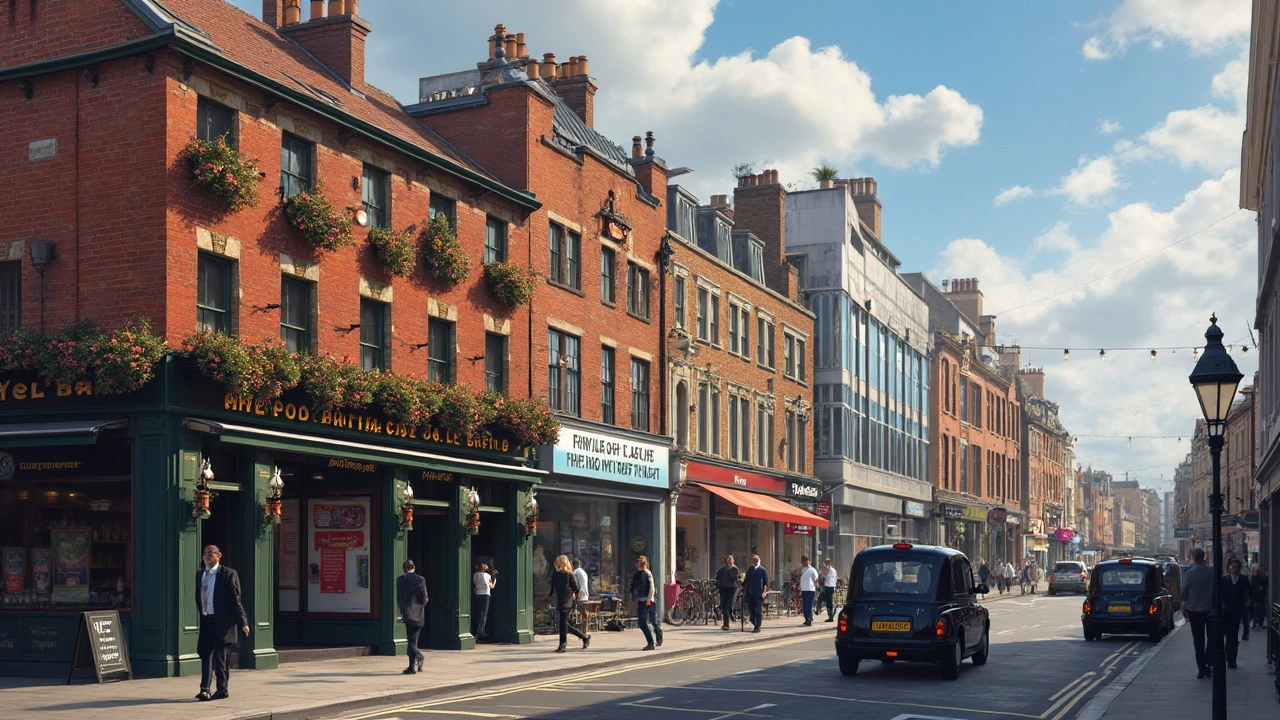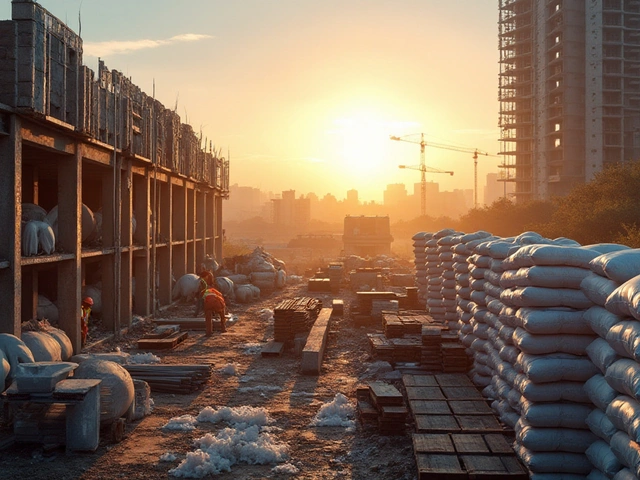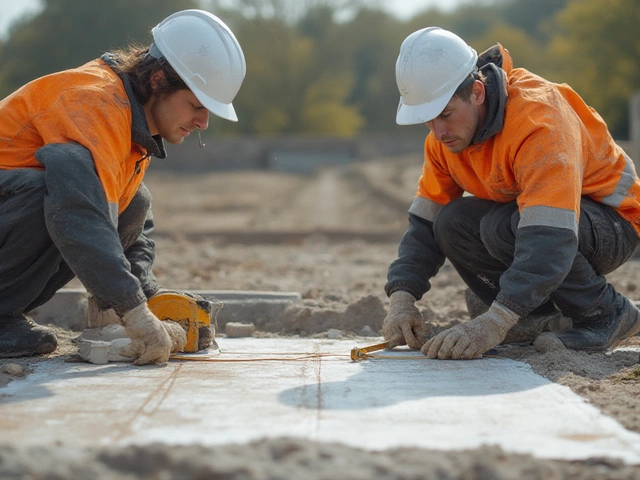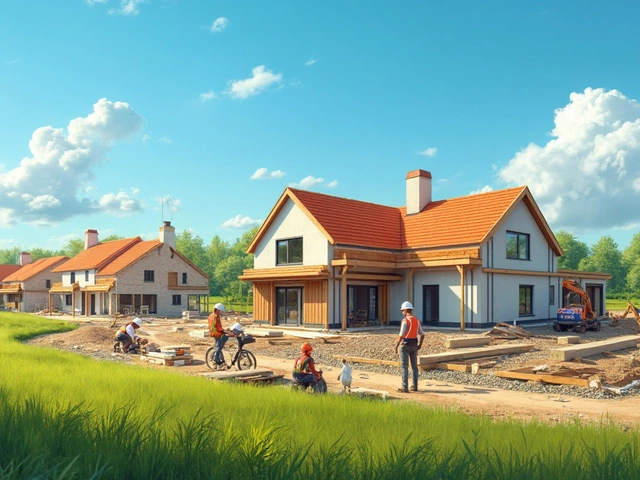Walk down any city street, and it can be tricky to spot what counts as a commercial building. Is it just about the look? Not really. What matters most is how the building is used. If the main purpose is to make money—think selling stuff, offering services, or offices—it’s considered commercial.
This difference isn’t just about who walks through the doors. It affects insurance, taxes, rules you have to follow, and even who can rent or buy the space. If you’re eyeing a property for your next shop or startup headquarters, knowing the basics about commercial buildings saves you a lot of headaches.
Don’t fall for the myth that every big, busy-looking building is commercial. There's more to the story—like zoning, special building standards, and safety rules that shape what owners can (and can't) do. So, what puts a building in the 'commercial' club? That’s what we’ll break down—clear, simple, and with plenty of real-world examples.
- Defining a Commercial Building
- Common Uses of Commercial Buildings
- Key Features That Set Them Apart
- Zoning and Legal Stuff
- Building Codes and Safety Rules
- Tips for Buyers and Tenants
Defining a Commercial Building
So, what exactly makes a building a commercial building? It comes down to one main thing: the building’s main job is to make money through business activities. If a place is being used to sell products, offer services, or run offices, it falls under the commercial category. That means stores, hotels, restaurants, office towers, shopping malls, and even banks. It’s not about size or style. It’s all about how the property gets used day to day.
It’s easy to get commercial and residential buildings mixed up. Residential spots are just for living—think houses, condos, or apartments. Commercial buildings are for business, even if people work there instead of live there. Sometimes, you’ll find buildings that have a mix of both, like a ground-floor shop with apartments up top. Those are called mixed-use buildings, but the business zone still counts as commercial.
Insurance companies, tax folks, and city building inspectors all treat these buildings differently. Why? Businesses attract more foot traffic, deal with higher safety risks, and follow stricter rules. Here’s a look at how commercial buildings stack up to other popular types:
| Type | Main Use | Typical Examples |
|---|---|---|
| Commercial | Business activities | Retail stores, offices, restaurants |
| Residential | Living spaces | Houses, condos, apartments |
| Industrial | Production/storage | Factories, warehouses |
Fun fact: According to the U.S. Energy Information Administration’s 2023 survey, there were over 5.9 million commercial buildings in the United States. That’s more than double the count from 1979. Commercial spaces are everywhere—from tiny local shops to giant corporate headquarters.
If you’re checking out a property and want to know its category, zoning records at your local city hall can tell you right away. Don’t rely on outside appearances; what’s happening inside is what really sets commercial buildings apart.
Common Uses of Commercial Buildings
If you picture a commercial building, you might think of a glass office tower or a busy grocery store. But the list is way longer and more varied than most people expect. Everything from a corner café to a huge movie theater falls into this group.
The key is the main activity inside the building—if it’s about business or making money, chances are it’s commercial. Take a look at where you might find these buildings in action:
- Retail stores: Think malls, shopping plazas, or even standalone supermarkets. If you can buy stuff there, it’s retail.
- Offices: Spaces for law firms, tech companies, dentists, real estate agencies—you name it. Most downtown buildings are packed with offices.
- Restaurants and cafés: Any place you sit down (or grab and go) for a meal usually counts as commercial property.
- Hotels and motels: Any property where people pay to stay overnight.
- Entertainment venues: Gyms, bowling alleys, movie theaters, escape rooms—if you buy a ticket, it’s a commercial operation.
- Healthcare clinics: Not hospitals, but places like urgent care centers, physical therapy clinics, and dental offices.
- Mixed-use buildings: Some combine commercial on the ground floor (like a hair salon) and apartments up above. If a part of the building is mainly for business, it’s got a commercial side.
Here’s something you might not know: the U.S. Energy Information Administration says office buildings make up about 18% of all commercial floor space, while retail and service buildings make up about 15%. That’s a lot of work and shopping going on under commercial roofs.
| Type | Share of Commercial Floor Space (%) |
|---|---|
| Offices | 18 |
| Retail & Service | 15 |
| Storage/Warehouse | 12 |
| Food Service | 4 |
| Lodging | 5 |
| Healthcare | 8 |
Some commercial buildings have more than one use. For example, a strip mall might have a gym, a pizza place, and a vape shop all under one roof. What ties them together? All those businesses are focused on selling a product or a service.
When you hear "commercial building," just remember: it’s a place where business gets done—no matter if it’s a corner bakery or a five-story dentist office complex.
Key Features That Set Them Apart
Commercial buildings have some tell-tale signs that set them apart from your average house or apartment. First, they're built to handle a lot more foot traffic. From lobbies with wide entryways to heavy-duty elevators, these spots are made to keep lots of people moving safely and efficiently. Think of an office building during rush hour or a grocery store packed on a Saturday afternoon.
They’re designed with business in mind, not cozy living spaces. You’ll find open layouts for shops and restaurants, cubicles and meeting rooms in offices, and loading docks if it’s a warehouse or retail hub. Commercial HVAC systems are usually much more powerful than what you’d see in homes, since they need to heat or cool big spaces all day, every day. Fire safety is also next-level compared to residential spots, with things like sprinkler systems, multiple exits, and fireproof materials being standard.
One of the clearest distinctions? Utility capacity. Commercial buildings have beefed-up electrical, water, and waste setups. This lets them support giant fridges in restaurants, tons of computers in offices, and all sorts of machinery in bigger facilities. Maintenance access—think janitor rooms, roof access, and service elevators—is another thing residential spaces rarely have at this scale.
Let’s look at a few core differences with some data:
| Feature | Commercial Building | Residential Building |
|---|---|---|
| Main Use | Commercial building: business, retail, office, hospitality | Housing people to live in |
| Foot Traffic Capacity | High (hundreds to thousands daily) | Low (dozens at most) |
| Fire Safety | Sprinkler systems, alarms, multiple exits | Usually just smoke alarms, fewer exits |
| Utility Demand | Heavy-duty electric, HVAC, plumbing | Standard, designed for comfort |
| ADA Compliance | Usually required (ramps, signage, wide doors) | Rare unless multi-family or public access |
Another thing to keep in mind: most commercial buildings have to follow ADA guidelines for accessibility. That means ramps, elevators, and signage for folks with disabilities aren’t optional—they’re required in most cases. Not following these rules can lead to fines and lawsuits. If you’re planning to lease or renovate a spot for your own business, always ask when those systems were last updated—they can be expensive to bring up to code if you miss them.
Bottom line: if a building’s got tough fire protection, accessibility features, and serious infrastructure for power and water, it’s probably in the commercial club. Skipping on these basics isn’t just risky—it’s usually not allowed by law.
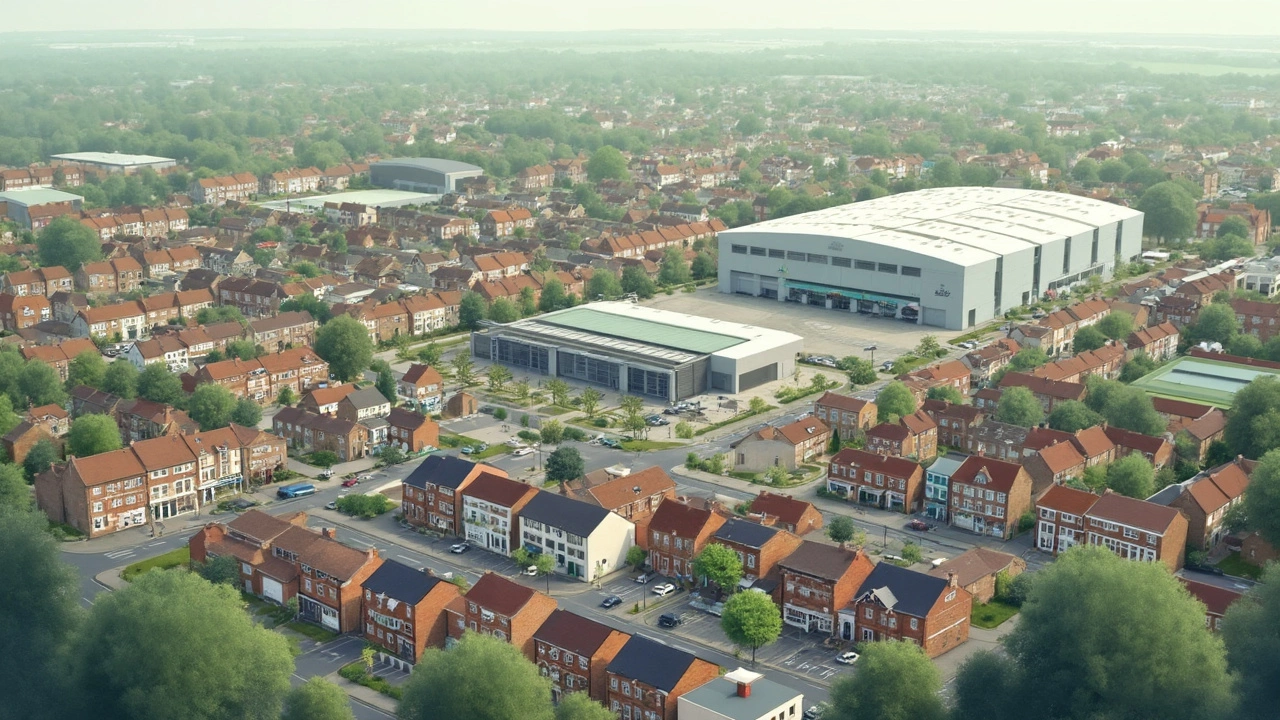
Zoning and Legal Stuff
You can’t talk about any commercial building without touching on zoning. Zoning is basically how a city or town decides what can be built where—think ‘rules of the land.’ If you want to open a business somewhere, just owning a building isn’t enough. You need the right zoning. For example, you can’t run a car repair shop out of a place zoned for apartments, no matter how roomy the garage is.
Most cities draw the line between residential, commercial, industrial, and sometimes “mixed-use” zones. Commercial zones let you run shops, offices, restaurants, or even hotels. If the property sits in a strictly residential zone, launching a business there can get you in serious trouble. Sometimes, you’ll spot a ‘C’ for commercial on city zoning maps, or codes like C-1, C-2 for different types (like neighborhood retail vs. large shopping centers).
Here’s a quick comparison of zoning types in major U.S. cities:
| City | Main Commercial Zoning Code(s) | Typical Allowable Uses |
|---|---|---|
| New York City | C1, C2, C4, etc. | Retail, offices, services, restaurants, some mixed-use |
| Los Angeles | C1, C2, C4, CR, etc. | Shops, personal services, some light industry |
| Chicago | B1, B2, B3, C1, C2, C3 | Business, retail, entertainment, offices |
There are more rules. Besides zoning, most places layer on extra legal stuff. You’ll run into things like permits, business licenses, and rules for signage, trash, even the type of lighting you can have. And let’s not forget parking—commercial properties usually require a set number of parking spaces per square foot.
- If you’re thinking about buying or leasing, check with your city’s planning department before you sign anything.
- Don’t trust a real estate ad that just says ‘commercial.’ Ask to see proof—a zoning certificate usually does the trick.
- If you want to change how you use a building (like turning an old warehouse into a coffee shop), you might have to apply for a zoning change or special permit. That could mean public hearings and paperwork.
One more thing: certain types of commercial businesses, like liquor stores or cannabis dispensaries, have even stricter rules about their location. Some cities add setback requirements, meaning you can’t open up too close to schools or churches. So, whatever your plan, always double-check the legal details before making a move. It’s way easier than having to undo a bad decision later.
Building Codes and Safety Rules
Here’s where things get real—no one just builds a commercial building and calls it a day. Every commercial space has to follow strict building codes and safety rules. These aren’t there to make life hard—they keep people safe and businesses running smoothly. Plus, if you skip any of these, insurance might not cover you, or the city could actually shut you down.
Commercial buildings have to meet standards that homes usually don’t. For example, you need fire alarms, sprinklers, exits that are easy to use in an emergency, and sometimes wheelchair ramps and elevators. These things are there to protect not just people who work there, but also customers and visitors. Here’s what’s commonly required:
- Fire safety: This means having fire extinguishers, smoke detectors, emergency lights, and working sprinkler systems in most types of commercial properties.
- Structural strength: Commercial buildings need to support more people and heavier loads than a typical house, so the foundation, floors, and roofs have to be much tougher.
- Accessibility: The Americans with Disabilities Act (ADA) says public spaces need to be open to everyone, so you’ll often see ramps, elevators, and special bathroom stalls.
- Ventilation and air quality: Proper heating, ventilation, and air conditioning aren’t just about comfort—they’re part of the code.
- Emergency exits: Clearly marked and easy-to-reach exit doors are required, often with strict rules on width, lighting, and signage.
Codes can change from one city to another. For example, California requires stricter earthquake safety rules than most states, and New York City has some of the toughest fire codes in the country. No matter where you’re building, you’ll have to get inspections at several stages. Skipping just one checkpoint, like fire suppression or accessibility, can mean serious fines.
| Feature | What's Required? | Why It Matters |
|---|---|---|
| Fire Alarms & Sprinklers | Mandatory in almost all commercial buildings | Alerts and protects everyone during fires |
| Emergency Exits | At least two, well-marked and unlocked during hours | Speeds up evacuation if something goes wrong |
| Accessibility (ADA) | Wheelchair ramps, accessible restrooms | Makes sure everyone has access |
| Structural Standards | Extra weight support and sturdy construction | Handles crowds and heavy equipment safely |
| HVAC Ventilation | Regulated air flow and filtration | Better air quality, fewer health problems |
If you’re looking at buying or leasing a commercial space, don’t just trust appearances. Ask for the building's latest inspection reports, check if it’s up to code, and see if any upgrades are coming up soon. Saving a bit during purchase isn’t worth it if you end up dealing with safety violations later. It’s the fastest way to tank a new business or blow the renovation budget.
Tips for Buyers and Tenants
Thinking about buying or leasing a commercial building? There’s a lot more to it than picking out your dream location and signing papers. You’ve got to cover your bases, or you could end up with surprise fees, slow permits, or a building that just doesn’t fit your needs.
Start by knowing what you actually need. Is this for a retail shop, restaurant, clinic, or an office space? The type shapes everything—layout, parking, even bathroom rules. And don’t forget about zoning. If a place isn’t zoned for your type of business, you could get shut down before you even open.
Here’s a quick checklist that most pros follow:
- Get a real inspection: Commercial building inspections often go way deeper than home inspections. Think HVAC, sprinklers, even ADA accessibility. A missed issue can get expensive fast.
- Check the zoning and permits: Don’t just ask—see proof from the city or county that your business is allowed in that space. Lots of folks get burned on this one.
- Understand lease types: Commercial leases can be triple-net, gross, or modified. Know who pays for what—property tax, repairs, cleaning, etc. This really messes with your budget if you don’t get it right up front.
- Plan for parking and accessibility: Local rules sometimes require a certain number of parking spots or wheelchair ramps. If you don’t have what you need, fixing it later sucks up time and cash.
- Look at utility capacities: Running a bakery and running a law office are two different ballgames. If the power, water, or ventilation aren’t up to spec, upgrades can take months (and money).
- Negotiate renovation clauses: If you want to change the space—move walls, change signage, add tech—make sure your lease spells out what’s allowed and how approvals work.
- Talk to neighbors: Existing tenants can warn you about surprise costs, slow security, or weird quirks in the building. Sometimes the best info comes from people already there.
Some numbers help put it all in perspective. Here’s a snapshot of typical cost and lease length differences:
| Type of Space | Average Price per Sq Ft (2025) | Typical Lease Length | Common Upfront Costs |
|---|---|---|---|
| Office | $22 - $40 | 3-7 years | 1-3 months' rent, security deposit |
| Retail | $25 - $60 | 5-10 years | First/last month’s rent, fit-out cost |
| Industrial | $8 - $18 | 3-10 years | Security deposit, build-out allowance |
A final tip: Build in extra time and money. Most commercial deals take weeks longer than folks expect to close and get set up—inspections, paperwork, and city sign-offs can slow you down. Plan for it and you won’t be caught by surprise.

